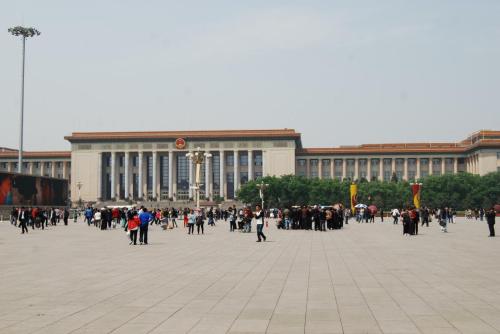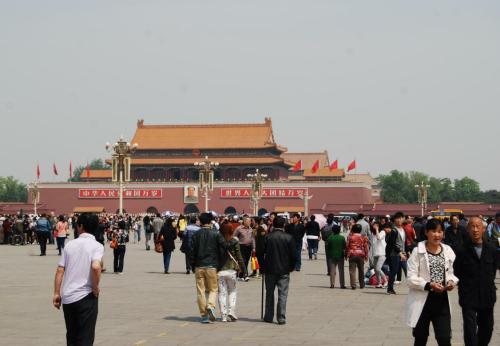
If you like your personal space, or don’t like crowds, possibly China isn’t really the place for you. The country has so many attractions, some of which are World Heritage Sites, so not only do they attract visitors from all over the world, but the Chinese themselves are extremely mobile, and like to see what is to be seen.
Some guide-books complain about this. ‘If you were expecting …. you will be disappointed’ says one. I saw a lot of stuff; most of it was crowded. But, one thing I wasn’t was disappointed. So, if these factors can be accepted, a visit to China is rewarding indeed.
We arrived at Beijing airport early in the morning … VERY early in the morning, ‘our time’ and were met by our National Escort. She quickly shepherded us on to a coach to take us to the hotel, and said that, although nothing was really planned for that day, she’d arranged lunch and dinner for us. There were, she said, two kinds of restaurant we’d use; the ‘traditional’ and the ‘tourist’ restaurant, and, where she could, she’d take us to a ‘traditional’ one.
Now, there are some people who say the Chinese food you get at the Happy Dragon or wherever at home is ‘nothing like what they eat in China’. For such people, I have only two words … the first is ‘bull’! Maybe there’s a little less meat and more vegetables, but they’re basically the same.
For our first visit the following morning, we went to the centre of Beijing to see the famous Tiananmen Square.
This is the largest city square in the world, and was laid out on the orders of Mao Zedong, whose mausoleum, containing his preserved remains, lies within the square. You can see him if you’re prepared to queue for hours, and pass through Security. We gave it a miss.
Both on the way here, and from the airport, we noted the frantic pace of the Beijing traffic. I gave them 10 out of 10 for skill, but 0 out of ten for road sense. I remembered, from years ago, the words of a Jordanian bus driver:
‘There are very few accidents here, because everyone expects the other guy to do something stupid’
Maybe that’s the case here?
While there are no cars on the square, the pace is still as frantic … even though the name translates as ‘The Gate of Heavenly Peace’. The gate from which the square takes is name, called, unsurprisingly, the Tiananmen Gate, stands on one side of the square, and contains a huge portrait of Chairman Mao. This is where a lot of groups like to have their group photo taken, before entering the Forbidden City.
Guidebooks say the Tiananmen Gate leads to the Forbidden City. It doesn’t really; it actually leads to the gate that leads to the Forbidden City. Nevertheless, it was towards the Tiananmen Gate, to see the city that is forbidden no longer.
But why was it ‘forbidden’? In the past, this was where the Emperor lived; he wasn’t satisfied with a mere palace, he had to have a ‘city within a city’. And, here dwelt his family, his concubines, his court, Government officials, civil and military … the rest of the population was excluded, but still, a sizeable area was needed to house all those who were entitled.
Nowadays, it’s one vast, beautifully preserved museum, where you can admire the exquisite, sometimes extravagant architecture … and even, if you look really hard, find a quiet corner away from the crowds.
I’ve only given a short, thumbnail sketch here, for we only had a couple of hours. I think, though, even if you lived in Beijing, you’d need a considerable time to see it all.
But, it’s not all museum … we found a restaurant, where we had lunch!
The Emperor didn’t always stay in the Forbidden City. Twice a year, at the Spring and Autumn Equinoxes, he came to the Temple of Heaven to pray for a good harvest.
The Temple was commenced in 1420, under the Ming Dynasty, and actually represents Heaven, as they conceived it at the time. The thinking was that Heaven was round, like the central three-tiered Hall of Prayer, and the Earth was square, like the walls surrounding it. And, it was purposely built over a greater area than the Forbidden City, for the Chinese believed that Heaven had to be larger than the Emperor’s earthly residence.
It stands amid extensive gardens, and was opened as a public park in 1988. The story behind it was a little too much to take in in one short visit … but it was still worth it, just to admire the architecture. And so, to dinner!
Like anywhere else, Chinese food has its regional specialties, too. On our first night we had Peking Duck (you knew, didn’t you, that Peking and Beijing are the same place?). Unlike Bombay Duck, though, it really is a duck! The way to eat it … they gave us a demonstration … is to roll it up in a little pancake, with strips of onion and cucumber, with a drizzle of soy sauce.
Now, I seem to remember reading (I think Ken Hom said it??) that soy sauce should always be used as a cooking ingredient; never as a condiment. But, I saw Chinese and Europeans alike happily splashing it on their food, so maybe Ken Hom (if it was him) was wrong. Or, I’m wrong!
‘I like Chinese food’ said Tina, when I got back ‘But, I couldn’t eat it for three weeks straight, like you did’.
I don’t blame her for making such a comment. Before I went to China, I’d have said pretty much the same thing. But, as in English … or just about any cuisine … there’s an almost infinite variety. If there’s anything you don’t like, you can always have something else.
Most of us ate with chopsticks … although, in most places, western cutlery could be provided on request.. Contrary to popular belief, it’s quite easy once you’ve had a little practice. But, you have to learn the chopstick etiquette as well; don’t use your chopsticks to take food from the communal bowl; never point at anyone with your chopsticks and never stick your chopsticks upright in your food.
But, to avoid making too much of a mess on the table cloth … reducing the distance between the plate and your mouth is quite acceptable!

Comments